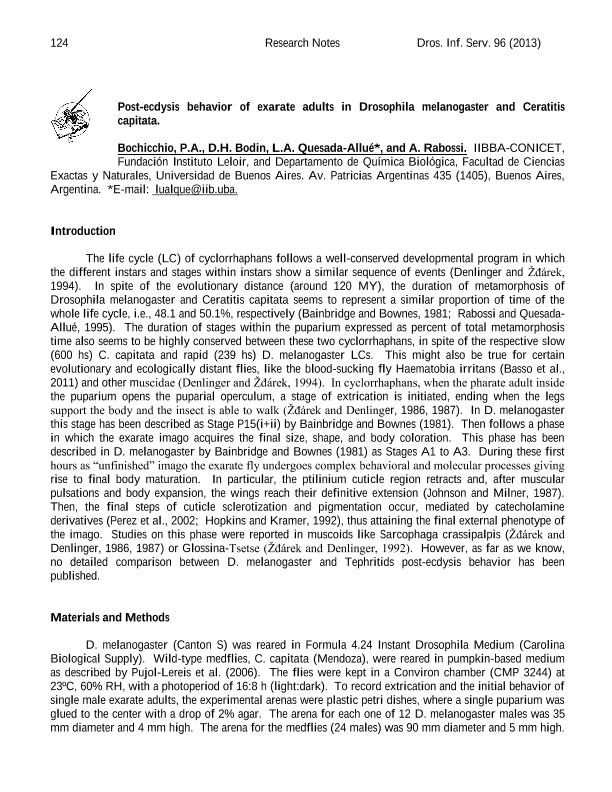Mostrar el registro sencillo del ítem
dc.contributor.author
Bochicchio, Pablo Alejandro

dc.contributor.author
Bodin, Diego H.
dc.contributor.author
Quesada Allue, Luis Alberto

dc.contributor.author
Rabossi, Alejandro

dc.date.available
2017-06-23T14:16:46Z
dc.date.issued
2013-12
dc.identifier.citation
Bochicchio, Pablo Alejandro; Bodin, Diego H.; Quesada Allue, Luis Alberto; Rabossi, Alejandro; Post-ecdysis behavior of exarate adults in Drosophila melanogaster and Ceratitis capitata; University of Oklahoma; Drosophila Information Service; 96; 12-2013; 124-127
dc.identifier.issn
0070-7333
dc.identifier.uri
http://hdl.handle.net/11336/18726
dc.description.abstract
The life cycle (LC) of cyclorrhaphans follows a well-conserved developmental program in which the different instars and stages within instars show a similar sequence of events (Denlinger and Žđárek, 1994). In spite of the evolutionary distance (around 120 MY), the duration of metamorphosis of Drosophila melanogaster and Ceratitis capitata seems to represent a similar proportion of time of the whole life cycle, i.e., 48.1 and 50.1%, respectively (Bainbridge and Bownes, 1981; Rabossi and QuesadaAllué, 1995). The duration of stages within the puparium expressed as percent of total metamorphosis time also seems to be highly conserved between these two cyclorrhaphans, in spite of the respective slow (600 hs) C. capitata and rapid (239 hs) D. melanogaster LCs. This might also be true for certain evolutionary and ecologically distant flies, like the blood-sucking fly Haematobia irritans (Basso et al., 2011) and other muscidae (Denlinger and Žđárek, 1994). In cyclorrhaphans, when the pharate adult inside the puparium opens the puparial operculum, a stage of extrication is initiated, ending when the legs support the body and the insect is able to walk (Žđárek and Denlinger, 1986, 1987). In D. melanogaster this stage has been described as Stage P15(i+ii) by Bainbridge and Bownes (1981). Then follows a phase in which the exarate imago acquires the final size, shape, and body coloration. This phase has been described in D. melanogaster by Bainbridge and Bownes (1981) as Stages A1 to A3. During these first hours as “unfinished” imago the exarate fly undergoes complex behavioral and molecular processes giving rise to final body maturation. In particular, the ptilinium cuticle region retracts and, after muscular pulsations and body expansion, the wings reach their definitive extension (Johnson and Milner, 1987). Then, the final steps of cuticle sclerotization and pigmentation occur, mediated by catecholamine derivatives (Perez et al., 2002; Hopkins and Kramer, 1992), thus attaining the final external phenotype of the imago. Studies on this phase were reported in muscoids like Sarcophaga crassipalpis (Žđárek and Denlinger, 1986, 1987) or Glossina-Tsetse (Žđárek and Denlinger, 1992). However, as far as we know, no detailed comparison between D. melanogaster and Tephritids post-ecdysis behavior has been published.
dc.format
application/pdf
dc.language.iso
eng
dc.publisher
University of Oklahoma
dc.rights
info:eu-repo/semantics/openAccess
dc.rights.uri
https://creativecommons.org/licenses/by-nc-sa/2.5/ar/
dc.subject
Ecdisis
dc.subject
Díptero
dc.subject
Ciclorrafos
dc.subject.classification
Otros Tópicos Biológicos

dc.subject.classification
Ciencias Biológicas

dc.subject.classification
CIENCIAS NATURALES Y EXACTAS

dc.title
Post-ecdysis behavior of exarate adults in Drosophila melanogaster and Ceratitis capitata
dc.type
info:eu-repo/semantics/article
dc.type
info:ar-repo/semantics/artículo
dc.type
info:eu-repo/semantics/publishedVersion
dc.date.updated
2016-09-05T13:12:59Z
dc.journal.volume
96
dc.journal.pagination
124-127
dc.journal.pais
Estados Unidos

dc.journal.ciudad
Oklahoma
dc.description.fil
Fil: Bochicchio, Pablo Alejandro. Consejo Nacional de Investigaciones Científicas y Técnicas. Oficina de Coordinación Administrativa Parque Centenario. Instituto de Investigaciones Bioquímicas de Buenos Aires. Fundación Instituto Leloir. Instituto de Investigaciones Bioquímicas de Buenos Aires; Argentina
dc.description.fil
Fil: Bodin, Diego H.. Consejo Nacional de Investigaciones Científicas y Técnicas. Oficina de Coordinación Administrativa Parque Centenario. Instituto de Investigaciones Bioquímicas de Buenos Aires. Fundación Instituto Leloir. Instituto de Investigaciones Bioquímicas de Buenos Aires; Argentina
dc.description.fil
Fil: Quesada Allue, Luis Alberto. Consejo Nacional de Investigaciones Científicas y Técnicas. Oficina de Coordinación Administrativa Parque Centenario. Instituto de Investigaciones Bioquímicas de Buenos Aires. Fundación Instituto Leloir. Instituto de Investigaciones Bioquímicas de Buenos Aires; Argentina. Consejo Nacional de Investigaciones Científicas y Técnicas. Oficina de Coordinación Administrativa Ciudad Universitaria. Instituto de Química Biológica de la Facultad de Ciencias Exactas y Naturales. Universidad de Buenos Aires. Facultad de Ciencias Exactas y Naturales. Instituto de Química Biológica de la Facultad de Ciencias Exactas y Naturales; Argentina
dc.description.fil
Fil: Rabossi, Alejandro. Consejo Nacional de Investigaciones Científicas y Técnicas. Oficina de Coordinación Administrativa Parque Centenario. Instituto de Investigaciones Bioquímicas de Buenos Aires. Fundación Instituto Leloir. Instituto de Investigaciones Bioquímicas de Buenos Aires; Argentina
dc.journal.title
Drosophila Information Service

dc.relation.alternativeid
info:eu-repo/semantics/altIdentifier/url/http://www.ou.edu/journals/dis/DIS96/Bochicchio%20124.pdf
Archivos asociados
